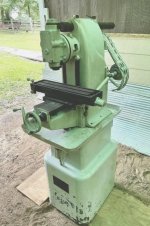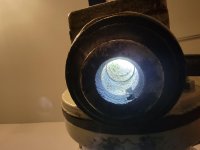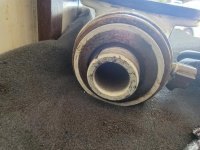Marty,
Thanks for sharing those pictures. I have been brainstorming multiple different options to increase the work envelope on this machine. I may create some brackets to move the spindle up to the top horizontal stabilizer arm. Should be a pretty simple modification.
Look up the OLD "Rockford" mini-mill.
Rockford Milling Machines USA
Support bar was hollow, carried a driveshaft and a large disk at the table end for the head to be swiveled on.
THEIR add-on head, OEM, not third-party, got the extra lift AND power from the back off the same motor as ran the horizontal spindle.
Not so much mass hanging off the arm that way. MUCH easier to lift the goods, too with no need of belted/geared/clutched mechanism in the head-end assembly. Those goods are at the BACK.
Now.. larger mill. USMT "Quartet" . a "combo" mill that already HAS a Vertical head on the opposite end of the ram atop its turret.. .
Some prior owner had face-bolted a simple steel plate to the front of the column above the end of the vertical dovetails, It has a hole to clear the horizontal spindle, and is dovetailed, left and right edge.
That dovetail fits a HEAVY K&T all-angle head.. powered off a 40-taper adapter from the 5 HP H-spindle motor (which has a Reeves VariDrive clone, hence lots of choices as to RPM).
Same rig also mounts a K&T 7+ inch vertical slotter head.
So I guess my "Quartet" was already a "Sextet" .. before I started messing with adding a cold-saw and grinder capability?
"Move over Rube Goldberg!"

Also, what is the difference in a 5V collet vs. 5C collet? Looks like there are plenty of 5C stuff floating around but not much 5V.
"Mark One Eyeball" off the photo sez Van Norman's 5V one had a longer closing taper - similar to the Gorton proprietary ones with the triangular-ish tails.
Not much in common AT ALL with the Hardinge 5C.
5C was though-bore optimized - good at feeding rod and bar stock on a lathe.
Gorton's collet was near as dammit closed-tail - optimized for grasping engraving or milling CUTTERS.
Van Norman may have had similar goals?
Most of the LATHES V-N made were for drum brake - then later-on, disc brake, rotor refinishing, not much else. Those were their dominant money-spinner, and found in MANY garages "back in the day" when all that was done "locally" rather than with an order to the local autoparts house for new . seldom - these days - even for "rebuilt".














